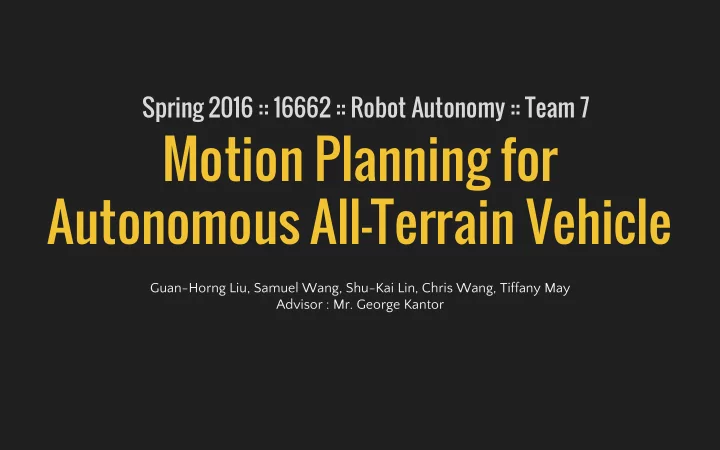

Spring 2016 :: 16662 :: Robot Autonomy :: Team 7 Motion Planning for Autonomous All-Terrain Vehicle Guan-Horng Liu, Samuel Wang, Shu-Kai Lin, Chris Wang, Tiffany May Advisor : Mr. George Kantor
OUTLINE Platform Introduction Motivation & Challenges Problem Formulation OMPL Framework ROS Planning PipeLine Collision Check Module RRT-Based Planner Module Final Demo
LiDAR Platform Introduction GPS/INS RGBD Camera Project Overview General purpose autonomous technology development for off-road driving in wilderness environment. Vehicle Platform 2016 YAMAHA Viking VI side-by-side ATV On-board Sensors Novatel, Velodyne 64, Multisense S21 Software Modules Classification, Pose Estimation, Global Planner, Local Planner Parter Field Robotics Center YAMAHA Motor Company, Japan YAMAHA Motor Corporation, USA
Motivation & Challenges Motivation Propose a new local planner for off-road navigation with ▪ Static obstacles avoidance ▪ High-speed maneuvering in complex vehicle dynamic Kinodynamic Planning in Control Space Challenges Uncertainty in Vehicle Dynamic Response Modeling e.g. Wheel-terrain interaction... Real-Time Implementation e.g. Anytime planning, Computational efficiency
5 7 5 Problem Formulation GOAL 50 Testing Scenario Design S-shape maneuvering with static obstacles avoidance Vehicle velocity with at least 20kph Model-based planner 25 Available Module/Sensor YAMAHA Velocity Controller (YVCA) LiDAR (point cloud), GPS/INS (position & velocity) 25 1.5 25 55 START
Show Time First
20kph
OUTLINE Platform Introduction Motivation & Challenges Problem Formulation OMPL Framework ROS Planning PipeLine Collision Check Module RRT-Based Planner Module Final Demo
OMPL :: Framework
OMPL :: OMPL.app KPIECE Planner RRT Planner
OMPL :: Benchmark Path Difference among multi planners Solving Time among multi planners
ROS Planning PipeLine /point_cloud Collision Check Rviz /visualization /odometry /goalpoint RRT-Based Planner Velocity Controller /vel_command
Collision Check Module Simplified Occupancy Grid Mesh RANSAC Segmentation Height Map Algorithm Implemented Approach
Collision Check :: Simplified Occupancy Grid ▪ Count only increases Obstacle ▪ If ( count > threshold ) → obstacle + Velodyne
Collision Check :: Mesh ▪ Use Open Dyanmic Engine (ODE) to cast ray from 4 wheels down to the mesh ▪ Calculate vehicle pitch and roll from 4 contact points ▪ Collision condition: o Pitch > threshold o Roll > threshold o Mesh interact with the ray between two wheels
Collision Check :: RANSAC Segmentation ▪ Use RANSAC to obtain a cloud fitting to the plane model ▪ Get point cloud outliers to extract obstacles
Collision Check :: Height Map Algorithm ▪ Calculate the height difference of multiple points within one grid ▪ If (height_difference > threshold) → It’s an obstacle Max height Min height
Collision Check :: Implemented Approach ▪ Requirement: Efficiency + Reliability ▪ Efficiency 1. Using height map algorithm as final approach for efficiency 2. Bit-wise operation for faster multiplication ▪ Reliability 1. Using obstacle counter for more robust detection 2. Dilate obstacle size
RRT-Based Planner Design SE2 + R 3 vehicle-frame velocity Why RRT ? ▪ High dimensional planning w/ complex dynamic model 6 DoF ▪ Smooth maneuvering state x 2 DoF control input u = (forward & angular vel.)
RRT-Based Planner Design SE2 + R 3 vehicle-frame velocity 6 DoF state x 2 DoF control input u = (forward & angular vel.)
RRT-Based Planner Design 1. Data-Driven Vehicle Dynamic Response Model 2. Control Shooting Method w/ Random Control Duration Flexible constraints between connect and extend RRT Steering Mechanisum Constraint in Control Space Extend Connect
RRT-Based Planner Design 1. Data-Driven Vehicle Dynamic Response Model 2. Control Shooting Method w/ Random Propagation Steps 3. Sub-Optimization w/ Minimal Traveling Time x_extend’ One more step needed to reach RRT* in control space x_min x_extend Connect extened node to minimum node x_nearest [1] Jeong hwan Jeon, Emilio Frazzoli, “Anytime Computation of Time-Optimal Off-Road Vehicle Maneuvers using RRT*”
RRT-Based Planner Design 1. Data-Driven Vehicle Dynamic Response Model 2. Control Shooting Method w/ Random Propagation Steps 3. Sub-Optimization w/ Minimal Traveling Time 4. Replanning Solving loop in 20Hz, planner loop in 2Hz Estimate start state using dynamic model in 1. Path consistence among each planner loop Update start, collision map 0.5 sec Planner Loop Planner Loop Solve Solve Path Path Publish the lowest cost path 0.05 sec
30kph Final Demo Video Vehicle operation vel: 10 ~ 40 kph Base line requirement: 20 kph Final Demo here: ~ 30 kph
30kph – NG version Any Questions?
Recommend
More recommend